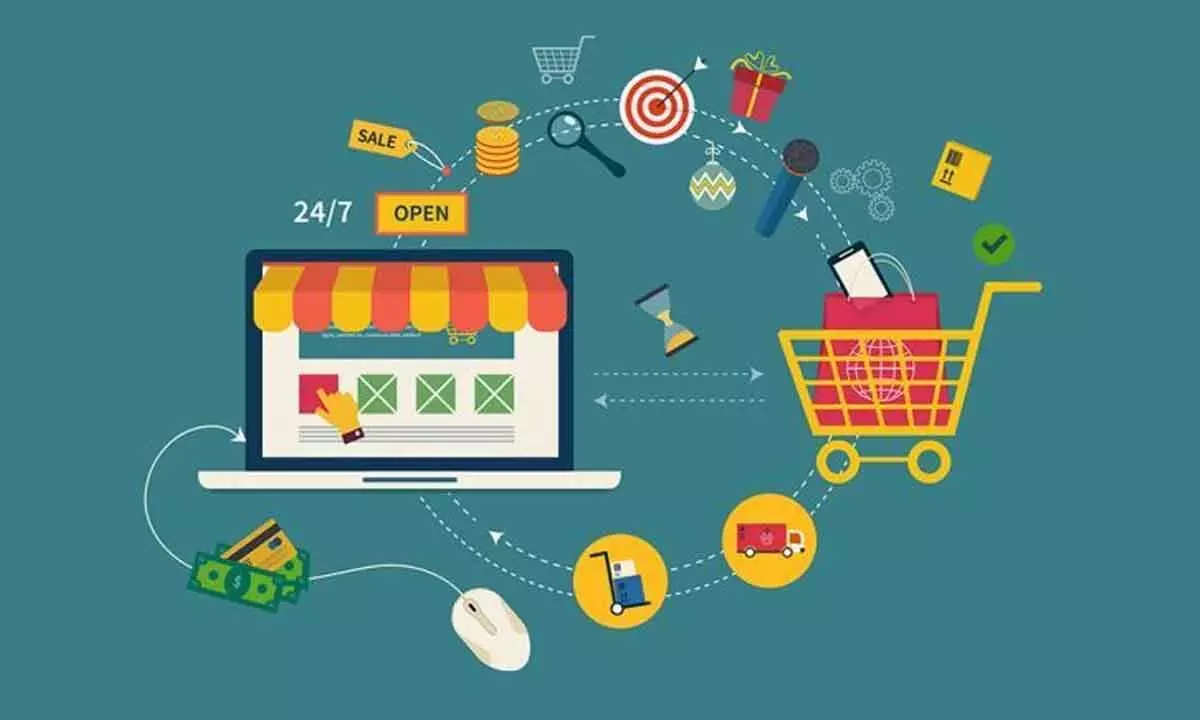It’s boom time for Indian e-commerce industry
Social media helps study consumer lifestyles and their spending patterns
image for illustrative purpose

Mobile penetration accounts for a vast market, making it more convenient for consumers to shop for a wide variety of retail products. E-commerce players have to address issues related to infrastructure needed to overcome payment problems, build offline presence, implement more push-marketing, manage price-sensitive customers, and compete on a global turf
The steady increase in the internet user base and favourable market conditions evidences that India has tremendous potential in the e-commerce industry. Growing at an exponential rate, the market value of the Indian e-commerce industry was approximately $22 billion in 2018. It is estimated to reach $350 billion by 2030.
The gradual change in the buying patterns of Indian consumers resulted in the mushrooming of start-ups in the e-commerce market. By offering options for payment on delivery and return policies, plus attractive deals and discounts, online retailers are enjoying an ever expanding online consumer base.
According to reports, India's e-commerce industry has some of the key players in the $100-million club, including, Amazon, Flipkart, Snapdeal, Ola Cabs, Paytm, InMobi, Zomato, Quikr and many start-ups that are boosting the sector’s growth.
According to NASSCOM, India's $14 billion e-commerce market that started as a niche industry a few years back, has been gaining momentum with a 25 per cent growth. Online travel is the largest segment with about 70 per cent market share, a figure that's likely to escalate.
E-commerce is expanding its reach to the general masses on the back of social media, which not only provides a mechanism for advertising but also for receiving feedback, building brand image, and promoting new launches. Online retailers also use social media to track first-time and repeat buyers of a product.
Social media has become a platform to study consumer lifestyles and spending patterns.
E-commerce, driven by digitization and internet penetration in the rural market, is creating huge opportunities for consumers. Competitive prices, deals, and efficient delivery coupled with the convenience of avoiding long queues have completely altered the buying experience.
A robust supply chain and a well-established reverse logistics network will enhance the success of Indian e-commerce companies. These enterprises seek a particular logistics requirement that may not be executed by traditional logistics suppliers. The courier companies that generally deliver documents are not experienced in delivering commercial goods. Thus, the e-commerce companies are establishing their own delivery network. One such example is Flipkart's logistics, which is E-commerce in Indiacalls "eKart." On the other hand, logistics vendors like Express Logistics deliver bulk loads to retailers and distributors. They have a pre-established working relationship with the dealers, enabling good execution.
E-commerce in India has experienced rapid growth driven by the millennials' (Generation Y) purchasing power, influence of the internet leading to development of varied mobile applications and websites, and the much-needed infrastructure. Mobile penetration accounts for a vast market, making it more convenient for consumers to shop for a wide variety of retail products.
E-commerce players have to address issues related to infrastructure needed to overcome payment problems, build offline presence, implement more push-marketing, manage price-sensitive customers, and compete on a global turf. The payment gateway infrastructure is still at a nascent stage. The merchants have yet to make amendments on the mobile front. As an example, one of the leading e-commerce players in India could not handle the requests of its customers on Big Billion Days' sale program due to unorganized delivery framework.
People from all fronts are using their smartphones to buy products and items.
With the big three — Amazon, Walmart, and Alibaba entering the Ecommerce sector, the market is slowly maturing and expanding its footprint to the most remote locations across the country. E-commerce is the convergence of convenient shopping, competitive pricing, discounts, etc. The changing market dynamics pave the way to a new model that includes hyper-local space with innovative transactional platforms, payment solutions, and a virtual brick-and-mortar retail experience. Old foundations based on price and quality will be replaced by a more enjoyable and richer user experience through guidance on selecting the right product and personalization.
The growth of core online retailers in India is driving brick-and-mortar stores to revamp their operations across regions.
According to an analysis, the Indian e-commerce industry grew from 4% of the total population in 2007 to around 40% in 2017, clearly indicating the rise of the internet era in the world's fastest-growing economy.
The growth of this market is expected to be around $188 billion by 2025 and thereon touch $350 billion by 2030, as per the latest statistical reports.
Thus the internet boom is directly proportional to the emergence of Ecommerce in India and other internet-based domains.

